Join our Larry McDonald on CNBC’s Trading Nation, Wednesday at 3:05pm ET
Updated at 7:30pm, April 18, 2017
BREAKING: *JAPAN’S 10-YEAR BOND YIELD FALLS TO ZERO, LOWEST SINCE NOV. 16
U.S. 10 Year Treasuries surged to fresh 2017 highs after Friday’s soft economic data and testosterone filled rage coming at markets out of the North Korea.
Market Participants Growing Doubt over the Fed’s Rate Hike Plans
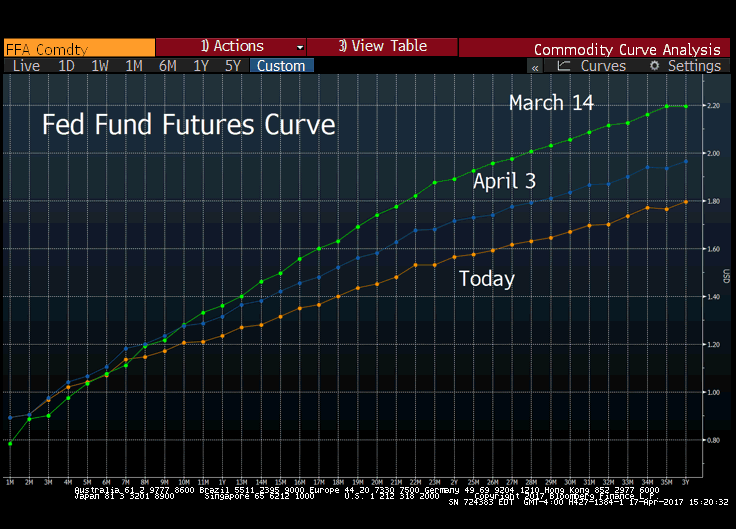
Bond futures players have grown more skeptical the Federal Reserve will raise interest rates aggressively this year. The Fed’s dot plot, central banker’s view on future hikes is up at two more for 2017. Implied rates on the fed fund futures curve are fully pricing in a September rate increase, with only a 20% percent chance of another by year-end. Bottom line, the spread between market participants and Fed governors views on future rate hikes has widened dramatically. Special thanks to Bloomberg’s Alexandra Harris (chart above).
New Highs for Unloved Bonds
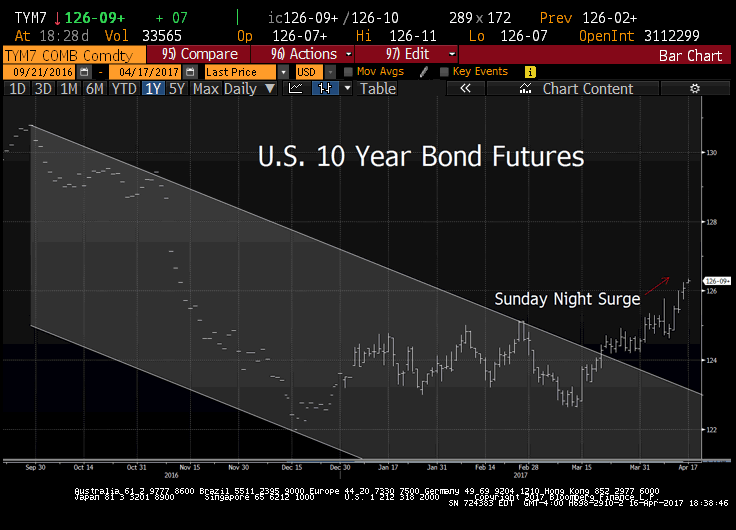
Overweight bonds, gold miners and emerging markets; we’ve done a solid job from clients in 2017. This week we’re focused the 50 percent retracement of the Trump Reflation Trade selloff at 2.178%.
All those “bond bears” have been hit with some heavy punches in recent weeks, a short covering capitulation climax is near.
1. A Dovish Surprise Fed Meeting with no movement in the Dots.
2. Paul Ryan’s Fumble – ACA repeal vote failure in the House, Tax Reform curveballs from Washington.
3. FOMC’s Dudley Bloomberg interview on the Fed’s balance sheet.
4. Soft March Jobs data.
5. Mother of all Bombs in Afghanistan, U.S. Missile Strikes in Syria, North Korea-Trump testosterone filled Verbal Slugfest.
6. Friday’s Colossal CPI, Retail Sales miss.
Pick up our latest note here:
Don’t miss our next trade idea. Get on the Bear Traps Report Today, click here“There is a disconnect between the Trump stimulus execution risk and how far we’ve come in terms of expectations. An actual fiscal boost is more than 12 months away in reality, Obamacare took well over 300 days to land on the President’s desk while the Dems controlled the House, Senate and the White House. As much as well all want to believe Mr. Gridlock is dead, he’s still breathing. As we head into 2017, gold miners, bonds, gold miners and utilities continue to be our favorite options as the street has unanimously bought into the “reflationary trade” narrative.”
The Bear Traps Report, January 5, 2017
Friday, the Atlanta Fed revised their Q1 2017 GDP forecast down to 0.5%, dangerously close to recession levels.
Atlanta Fed GDP Now Outlook
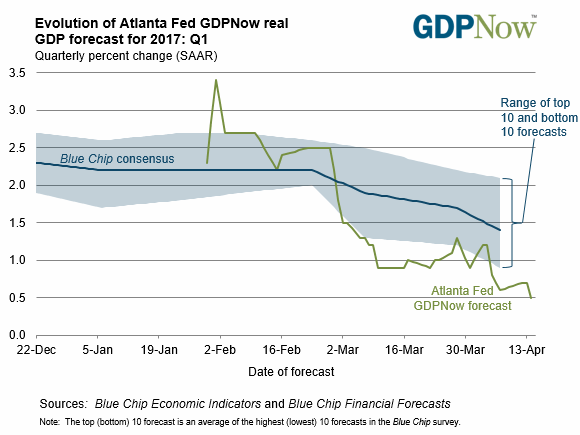
In just a few months the Atlanta Fed has moved from 3.4% to 0.5% economic growth outlook for Q1 2017. The Bottom line is wage data is NOT consistent with full employment. Average hourly earnings have risen at a very soft pace in recent months. Our Bear Traps Report wage tracker is treading water at 2.4% YoY over the past few quarters, that’s 0.60% below the rate is should be in a “full employment” economy.
On Bond Yields, Why Has Wall St. Been the Gang that Can’t Shoot Straight?
In our view, the current expansion’s full time job creation is 5 to 15 million short of what it should have accomplished.
1. The result is a large increase in underemployed, unemployed and idle individuals.
2. They number 129 million, 1.5 million less than the end of November 2016 and are over 50% of workforce.
3. In the eight years ended November 2016, their ranks increased over 10% by 12.53 million to 130.5 million.
4. The 129 million are unemployed, not in labor force and usually working part time.
With our Friend Chip Dickson
CPI Plunge
For the first time since February 2016, the cost of living in the U.S. declined in March. From 1986 to 2006, CPI inflation -month over month- results never printed below 0.0%, but since red prints have occurred seven times, the latest in March.
Core Fell, Most Since 1982
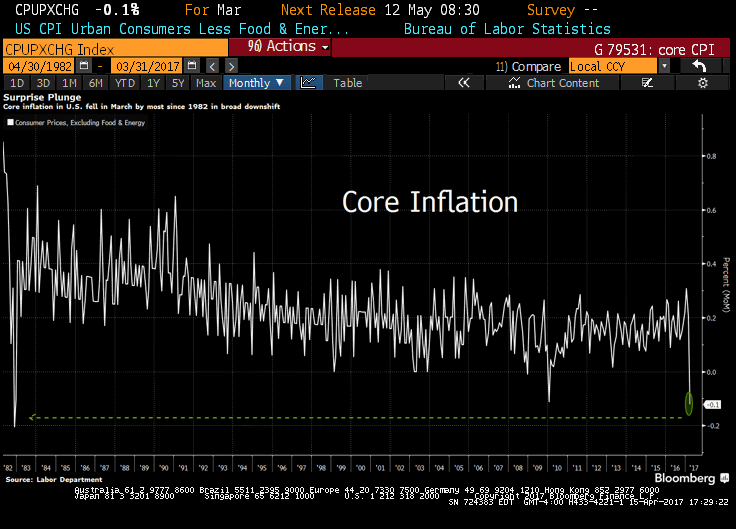
The drop in the core rate was the – recession like – eye opener. A reading this low almost never occurs outside meaningful economic contractions. Leading the way south were apparel and vehicle prices. It’s clear, the colossal supply of unsold automobiles has created substantial price dislocations in the USA. March light vehicle sales equate to 16.62 million seasonally adjusted annualized rate of cars sold – the slowest pace in 25 months. In our view, the glut of unsold automobiles had a heavy hand in the biggest drop in core CPI in over 30 years this week.
“If the bond market was open this morning, 10s (10 year U.S. Treasuries) would have traded at 2.00%, that’s a far cry from Wall St’s call for 3.20% by year end (Street yield consensus estimate).”
Larry McDonald, Creator of the Bear Traps Report
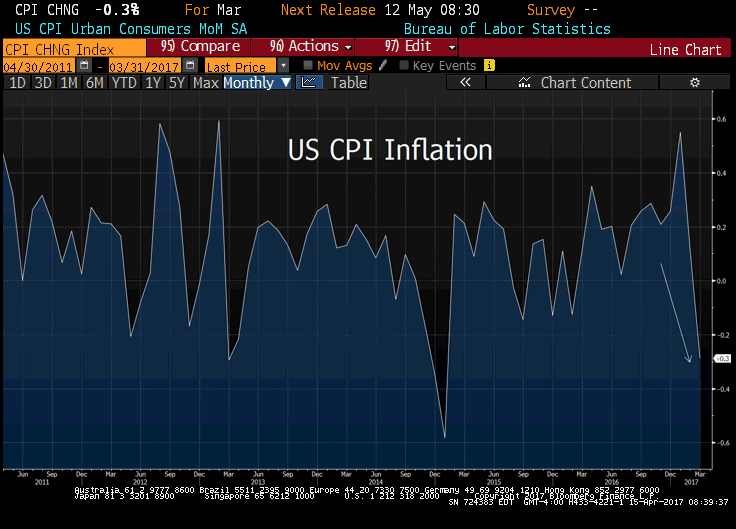 CPI M/M -0.3%, Exp. 0.0%
CPI M/M -0.3%, Exp. 0.0%
CPI Core M/M -0.1%, Exp. +0.2%
The data shows “just a crawl” for inflation, after such sky high expectations from Wall St’s “reflation trade.”
Friday, the U.S. dollar plunged to the lowest level in nearly six months versus the yen. After very weak inflation data, he greenback touched its the 200-day moving average first time since February 2016. In January, once again Wall St. sold their clients up the river on the “reflation trade” fantasy. In reality, today’s data shows core CPI (ex food and energy) fell for the first time since 2010.
Dollar Heading South after the Soft Data
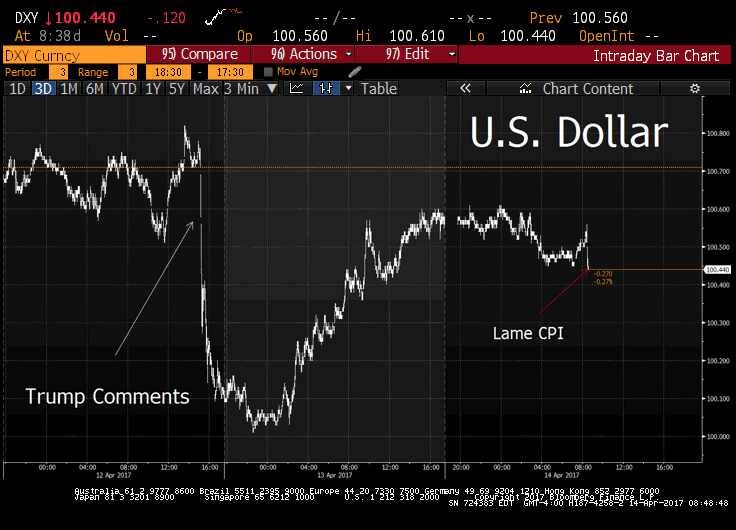 The decline — reflecting cheaper motor vehicles, wireless phones services and apparel — interrupts a recent pickup in inflationary pressures. Businesses have been regaining some pricing power on the heels of improving global demand and steady sales in the U.S. The Federal Reserve’s preferred gauge of inflation, a separate figure that’s based on what consumers purchase, exceeded its 2 percent goal in February, though some officials focus on the measure excluding food and energy, which is still below their target. The year-over-year gain in the March core CPI was the smallest since November 2015. – Bloomberg reported
The decline — reflecting cheaper motor vehicles, wireless phones services and apparel — interrupts a recent pickup in inflationary pressures. Businesses have been regaining some pricing power on the heels of improving global demand and steady sales in the U.S. The Federal Reserve’s preferred gauge of inflation, a separate figure that’s based on what consumers purchase, exceeded its 2 percent goal in February, though some officials focus on the measure excluding food and energy, which is still below their target. The year-over-year gain in the March core CPI was the smallest since November 2015. – Bloomberg reported
Pick up our latest note here:
Don’t miss our next trade idea. Get on the Bear Traps Report Today, click here“The Trump election surprise impact on markets presents us with a unique opportunity, rarely have we ever seen trades this crowded headed into the new year. We’ll take the road less traveled; recommend clients overweight utilities, bonds and emerging markets heading into 2017.”
The Bear Traps Report, December 12, 2016
-The consumer-price index decreased 0.3 percent (forecast was unchanged) following a 0.1 percent advance the prior month.
-From a year earlier, prices were up 2.4 percent (forecast was 2.6 percent) after a 2.7 percent gain.
-Excluding food and energy, the so-called core CPI fell 0.1 percent from the prior month, the first decrease since January 2010
-Core rate was up 2 percent from March 2016
Retail Sector Jobs and Core Inflation
When we look at retail sector employment growth, the plunge has been spectacular.
Historical Trend: +17 to +22k per month*
Last 4 Months -6k per month
*BLS data 1996-2006
How much of this weakness is due to the structural shift of retail sales from brick and mortar stores toward less labor-intensive e-commerce firms, and what is the likely future pace of retail job growth? Pick up our latest report.
Pick up our latest note here:
Don’t miss our next trade idea. Get on the Bear Traps Report Today, click hereGoldman, Before Today’s News
Even before today’s soft retail sales and CPI data, Goldman was hedging their bets lower:
“Our economists’ real GDP tracking estimate for Q1 has edged down further to just 1.4%, and other estimates are even lower. By contrast, even after Friday’s partly weather-driven slowdown in nonfarm payroll growth to 98k, our economists’ current activity indicator (CAI) for March is 3.6%, down from the February reading of 4.2% but still strong in absolute terms. In averaging these numbers, our analysts would put most of the weight on the CAI, partly because they think it is generally more stable and partly because GDP in the first quarter suffers from a downward seasonal bias of about 1pp. Our economists think that true growth is well above the US economy’s underlying trend of around 1.75%.”
Goldman Sachs, April 13, 2017



In addition to the fact that he is a brilliant analyst, Lawrence McDonald is, even more importantly, a class act.
Thank You Lawrence…